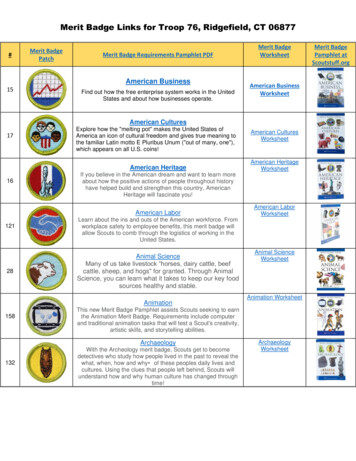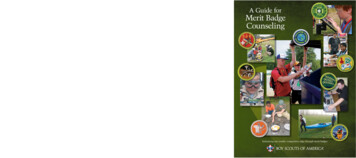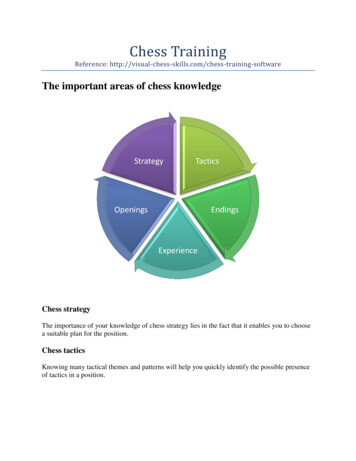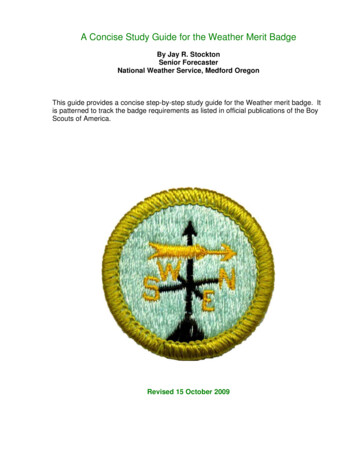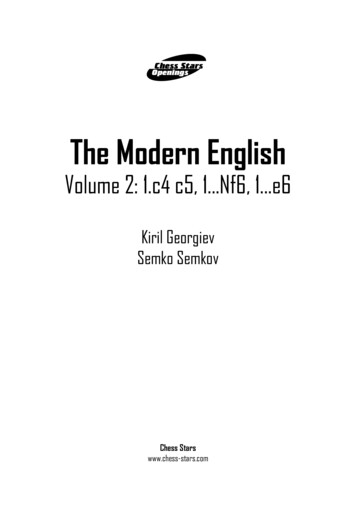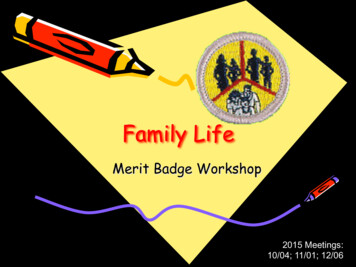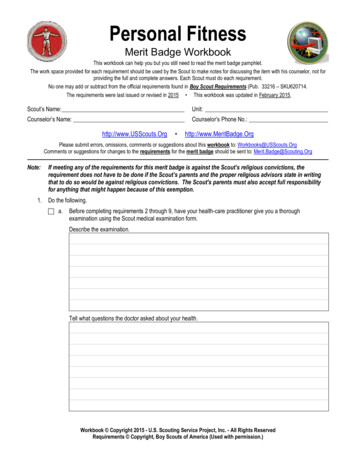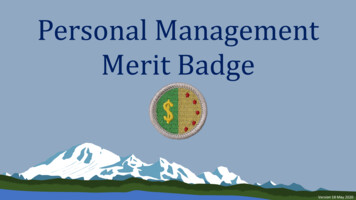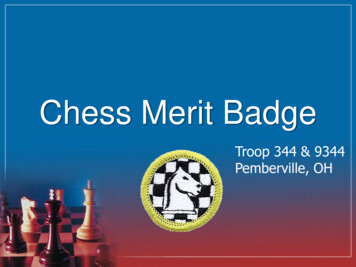
Transcription
Chess Merit BadgeTroop 344 & 9344Pemberville, OH
Requirements1. Discuss with your merit badge counselor thehistory of the game of chess. Explain why it isconsidered a game of planning and strategy.2. Discuss with your merit badge counselor thefollowing:a. The benefits of playing chess, including developingcritical thinking skills, concentration skills, and decisionmaking skills, and how these skills can help you inother areas of your lifeb. Sportsmanship and chess etiquette2
Requirements3. Demonstrate to your counselor that you knoweach of the following. Then, using Scouting’sTeaching EDGE, teach someone (preferablyanother Scout) who does not know how to playchess:a. The name of each chess pieceb. How to set up a chessboardc. How each chess piece moves, including castling and enpassant captures3
Requirements4. Do the following:a. Demonstrate scorekeeping using the algebraic systemof chess notation.b. Discuss the differences between the opening, themiddle game, and the endgame.c. Explain four opening principles.d. Explain the four rules for castling.e. On a chessboard, demonstrate a "scholar's mate" anda "fool's mate."f. Demonstrate on a chessboard four ways a chess gamecan end in a draw.4
Requirements5. Do the following:a. Explain four of the following elements of chessstrategy: exploiting weaknesses, force, king safety,pawn structure, space, tempo, time.b. Explain any five of these chess tactics: clearancesacrifice, decoy, discovered attack, double attack, fork,interposing, overloading, overprotecting, pin, removethe defender, skewer, zwischenzug.c. Set up a chessboard with the white king on e1, thewhite rooks on a1 and h1, and the black king on e5.With White to move first, demonstrate how to forcecheckmate on the black king.d. Set up and solve five direct-mate problems provided byyour merit badge counselor.5
Requirements6. Do ONE of the following:a. Play at least three games of chess with other Scoutsand/or your merit badge counselor. Replay the gamesfrom your score sheets and discuss with your counselorhow you might have played each game differently.b. Play in a scholastic (youth) chess tournament and useyour score sheets from that tournament to replay yourgames with your merit badge counselor. Discuss withyour counselor how you might have played each gamedifferently.c. Organize and run a chess tournament with at least fourplayers, plus you. Have each competitor play at leasttwo games.6
Requirement #1 Discuss with your merit badgecounselor the history of the game ofchess. Explain why it is considered agame of planning and strategy.7
History of the Game of Chess The history of chess spans some 1500 years. The earliest predecessors of the gameoriginated in India, before the 6th century AD. From India, the game spread to Persia. Whenthe Arabs conquered Persia, chess was takenup by the Muslim world and subsequentlyspread to Southern Europe. In Europe, chess evolved into its current formin the 15th century.8
History of the Game of Chess The game, as played during the early MiddleAges, was slow, with many games lasting fordays. Some variations in rules began to change theshape of the game by 1300 AD.– A notable, but initially unpopular, change was theability of the pawn to move two places in the firstmove instead of one. The queen and bishop remained relatively weakuntil between 1475 AD and 1500 AD, in eitherSpain, Portugal, France or Italy, the queen's andbishop's modern moves started and spread,making chess close to its modern form.9
History of the Game of Chess In Europe some of the pieces gradually gotnew names and/or moves:– Fers: "queen", because it starts beside the King.– Aufin: "bishop", because its two points looked like abishop's mitre.– Pawn moving two squares in its first move. This ledto the en passant rule: a pawn placed so that itcould have captured the enemy pawn if it hadmoved one square forward was allowed to capture iton the passed square.– King jumping once, to make it quicker to put theking safe in a corner. (This eventually led tocastling.)10
History of the Game of Chess In the second half of the 19th century,modern chess tournament play began, and thefirst world Chess Championship was held in1886. The 20th century saw great leaps forward inchess theory and the establishment of theWorld Chess Federation (FIDE). Developments in the 21st century include useof computers for analysis, which originated inthe 1970s with the first programmed chessgames on the market. Online gaming appeared in the mid 1990's.11
Chess: A Game of Planning and Strategy It is considered a game of strategy andplanning because during the game, you planand do certain strategies based on thepositional elements of the pieces.– These include pawn structure, king safety, pieceplacement and mobility. However, the answer is not quite as simple assaying that chess involves strategy andplanning.– The thing to notice is that chess does not involvechance.12
Chess: A Game of Planning and Strategy All of your theoretically possible next movesand your opponent's possible next moves thatare known, defined, and visible to both playerseffects your strategy and planning. The further ahead your brain can plan, thestronger you can become as a player. A player with better planning and strategy willalways win.13
Chess: A Game of Planning and Strategy Contrast this with a card game, and you willsee that some elements of the card gamedepend on chance -- what cards you will drawin gin rummy for example; or a board gamelike Monopoly where the outcome depends inpart on a roll of the dice. In a gin rummy or a monopoly gamesometimes luck will enable a player to win agame, even if his planning and strategy arenot as good as his opponents.14
Requirement #22. Discuss with your merit badge counselor thefollowing:a. The benefits of playing chess, including developingcritical thinking skills, concentration skills, anddecision-making skills, and how these skills can helpyou in other areas of your lifeb. Sportsmanship and chess etiquette15
The Benefits of Playing Chess Here is a short list of just some of the benefitsof learning and Playing Chess:– Provides practice at making accurate and fastdecisions under time pressure.– Drills skills that can help improve exam scores.– Improves reading.– Pattern recognition enhanced.– Teaches sportsmanship.– Dealing with difficult choices.– Making the best choice from a group of goodchoices.– Teaches to learn from mistakes.16
The Benefits of Playing Chess Here is a short list of just some of the benefitsof learning and Playing Chess:––––––––Responsibility for actions.Concentration is vigorously practiced.Logical reasoning is sharpened.Measurable individual accomplishments are enjoyed.Critical thinking.Memory is enhance.Problem solving and 'what if' skills.Intellectual maturity is fostered.17
The Benefits of Playing Chess Here is a short list of just some of the benefitsof learning and Playing Chess:––––––Belonging to a good crowd.Self esteem.Mind enrichment.Mental exercising.Analyzing actions and consequences.The importance of planning.18
Sportsmanship and Chess Etiquette Be polite, and get off to a good start. Don’t boast, talk trash, or try to intimidate youropponent. Don’t argue with your opponent. Don’t give or ask for advice. Don’t be annoying. Don’t try to trick your opponent by pretending tohave made a bad move. Do not rush your opponent. After your game, be a good winner or loser. Saying “check” is not required, but is consideredpolite.19
Requirement #33. Demonstrate to your counselor that you knoweach of the following. Then, using Scouting’sTeaching EDGE, teach someone (preferablyanother Scout) who does not know how toplay chess:a. The name of each chess pieceb. How to set up a chessboardc. How each chess piece moves, including castling anden passant captures20
The King The highest ranking Chess piece,and it can move one square at atime in any direction. When the king is placed in jeopardyof being captured, it is said to be incheck and must be moved, or thechecking piece blocked by anotherpiece. If the king is placed in check, and the kingcannot move to a safe square, and the dangercannot be blocked, or the checking piececaptured, the king is said to be in checkmateand the game is over.21
The King The King is the highest rankingChess piece, and it can move onesquare at a time in any direction. When the King is placed in jeopardyof being captured, it is said to be incheck and must be moved, or thechecking piece blocked by anotherpiece. If the King is placed in check, and the kingcannot move to a safe square, and thedanger cannot be blocked, or the checkingpiece captured, the king is said to be incheckmate and the game is over.22
The Rook The Rook, or Castle, can move oneor multiple squares in a straight linein any direction. There are two rooks per side, for atotal of four. It occupies the outside square of thevery back row, one on each side,one occupying a black square andone occupying a red square of thechess board.23
The Knight There are two Knights per side,four knights per chess set. The knight has the mostcomplicated move. It can move one square straight andone square diagonal any direction. It is the only piece which can movearound another piece. The knight occupies the square rightnext to the rook in the back row,again one on red and one on white.24
The Bishop Bishops also number two per side,and can move one or multiplesquares in any diagonal direction. These are located right next to theknight in the back row. These are the only pieces whichoccupy only one color square duringthe entire game.25
The Queen The Chess Queen is the mostpowerful piece on the board, andeach player has one. It can move one or multiplesquares, straight or diagonal. The queen is located to the right ofthe King at the beginning of thegame.26
The Pawn The Pawn is the weakest piece, as itcan only move forward one square at atime but, on its initial move, it maymove two squares. It cannot move backwards. There are eight pawns on each sideand at the start of play the entiresecond row of the board is occupied bypawns. If you advance a pawn to your opponent’s lastrow of squares, it can be promoted to a pieceof any rank above it, including the queen,(even if you already have one on the board.)27
How to Set Up a Chessboard28
Castling Castling can only occur if there are no piecesstanding between the king and the rook. Neither king nor the rook to be castled withmay have moved from its original position. There can be no opposing piece that couldpossibly capture the king in his originalsquare, the square he moves through or thesquare that he ends the turn.29
Castling The king moves two squares toward the rookhe intends to castle with (this may be eitherrook). The rook then moves to the square throughwhich the king passed.30
En Passant Captures En passant captures is a special pawncapture which can occur immediately after aplayer moves a pawn two squares forwardfrom its starting position, and an enemy pawncould have captured it had it moved only onesquare forward. The opponent captures the just-moved pawnas if taking it "as it passes" through the firstsquare. The resulting position is the same as if thepawn had moved only one square forward andthe enemy pawn had captured normally.31
En Passant Captures The en passant capturemust be done on thevery next turn, or theright to do so is lost. Such a move is the onlyoccasion in chess inwhich a piece capturesbut does not move to thesquare of the capturedpiece.32
Requirement #44. Do the following:a. Demonstrate scorekeeping using the algebraicsystem of chess notation.b. Discuss the differences between the opening, themiddle game, and the endgame.c. Explain four opening principles.d. Explain the four rules for castling.e. On a chessboard, demonstrate a "scholar's mate"and a "fool's mate."f. Demonstrate on a chessboard four ways a chessgame can end in a draw.33
The Algebraic System of Chess Notation Algebraic notation (or AN) is a method forrecording and describing the moves in a gameof chess. It is now standard among all chessorganizations and most books, magazines, andnewspapers.34
The Algebraic System of Chess Notation Each square of the chessboard is identified bya unique coordinate pair consisting of a letterand a number. The vertical rows of squares (called files) fromWhite's left (the queenside) to his right (thekingside) are labeled a through h. The horizontal rows of squares (called ranks)are numbered 1 to 8 starting from White'sside of the board.35
The Algebraic System of Chess Notation Thus, each square has aunique identification of fileletter followed by ranknumber. For example, the white kingstarts the game on squaree1, while the black knighton b8 can move to opensquares a6 or c6.36
The Algebraic System of Chess Notation Each type of piece (other thanpawns) is identified by anuppercase letter, usually the firstletter in the name of the piece inwhatever language is spoken bythe player recording. Pawns are not indicated by aletter, but rather by the absence ofany letter—it is not necessary todistinguish between pawns formoves, since only one pawn canmove to a given square.37
The Algebraic System of Chess Notation Each move of a piece isindicated by the piece'suppercase letter, plus thecoordinate of thedestination square. Forexample, e5 (black movesa pawn to e5—no pieceletter in the case of pawnmoves) Nf3 (move aknight to f3), .38
The Algebraic System of Chess Notation When a piece makes acapture, an x is insertedbetween the piece's letterand the destinationsquare. For example, Bxc6(bishop captures the pieceon c6).39
The Algebraic System of Chess Notation When a pawn makes acapture, the file fromwhich the pawn departedis used to identify thepawn, rather than a letterrepresenting the pawnitself. For example, exd5 (pawnon the e-file captures thepiece on d5).40
The Algebraic System of Chess Notation En passant captures arenotated by specifying thecapturing pawn's file ofdeparture, the x, thedestination square (not thesquare of the capturedpawn), and the suffix e.p.indicating the capture wasen passant. For example, exd3e.p.41
The Algebraic System of Chess Notation When two (or more) identical pieces can moveto the same square, the moving piece isuniquely identified by specifying the piece'sletter, followed by (in descending order ofpreference):1. The file of departure (if they differ); or2. The rank of departure (if the files are the same butthe ranks differ); or3. Both the rank and file (if neither alone is sufficientto identify the piece—which occurs only in rarecases where one or more pawns have promoted,resulting in a player having three or more identicalpieces able to reach the same square).42
The Algebraic System of Chess Notation For example, with rookson a1 and f2, either ofwhich might move to c3,the "a" must be includedto indicate which rook. Notice how the move isRaxc1. As noted above, an x isinserted to indicate acapture.43
The Algebraic System of Chess Notation When a pawn moves tothe last rank andpromotes, the piecepromoted to is indicatedat the end of the movenotation. Black captures White'sBishop on c1 withdxc1 Q.44
The Algebraic System of Chess Notation dxc1 Q means pawncaptures piece on c1 andpromotes it to a Queen. Black could promote it toany other piece hechooses, but Queen's arenearly always the bestchoice.45
The Algebraic System of Chess Notation See how white has madea special move calledcastling kingside. Thismove is written as 0-0. Ifthe King castles on thequeenside (to the otherdirection on thechessboard) it would bewritten as 0-0-0.46
The Algebraic System of Chess Notation A move which places theopponent's king in checkusually has the notation " "appended. Checkmate at the completionof moves is notated " ”. d4 “Checkmate” The notation 1–0 at thecompletion of movesindicates that White won, 0–1 indicates that Black won,and ½–½ indicates a draw.47
The Algebraic System of Chess Notation Notice how theprevious moves andnotations have beenshown on the samplescore sheet.48
Requirement #55. Do the following:a. Demonstrate scorekeeping using the algebraicsystem of chess notation.b. Discuss the differences between the opening, themiddle game, and the endgame.c. Explain four opening principles.d. Explain the four rules for castling.e. On a chessboard, demonstrate a "scholar's mate"and a "fool's mate."f. Demonstrate on a chessboard four ways a chessgame can end in a draw.49
Stages in the Game of Chess There are three distinct stages to the game ofchess that you need to know in order to be awinning chess player. These three stages are the:– Opening– Middle– Endgame. Each stage has different goals and objectives.50
Opening Stage The opening you want to get a rapiddevelopment of your primary pieces. You also want to safe guard your king,generally by castling. It is in this phase of the game that you wantto try and achieve dominance over the middlefour squares of the board. Generally the opening lasts between ten totwenty moves roughly.51
Middle Stage The middle game is when you begin tocoordinate your primary pieces and attackyour opponent‘s weak spots and open files. The goal is to win primary pieces from youropponent or even be able to checkmate youropponent. The middle game is approximately from theend of the opening phase until around moveforty.52
End Stage The end game is when you use your remainingprimary pieces to take advantage of theweaknesses that you created in youropponent‘s defense during the middle game. The endgame often concludes when one ofthe players is able to move a pawn to theother side of the board and thus turn thatpawn in for a queen. This is then followed by a checkmate or aresignation. Strategy, not tactics are what need to beconsidered in the end game.53
Classical Opening Principles The four major aspects of ClassicalOpening Principles are:1.2.3.4.CentralizationQuick DevelopmentEarly castlingKnights before Bishops54
Centralization The most important part in the chessboard is thecenter. Pieces placed in the center attack more squaresthan those positioned on the sides of the board.– A knight placed in “d4” can effectively attack eightsquares.– They are c2, b3, b5, c6, e6, f5, f3, and e2.– The same knight in h1 can attack only two squares – f2and g3. If you do not control or possess a fair share ofthe center, then it might be difficult to maneuverpieces from one side of the board to the otherside of the board.55
Quick Development The second important part of ClassicalOpening Principles is Quick Development. You might know that pawns are of the lowestcadre. The minor pieces such as bishops and knightsare the next cadre. The Queen and the rooks are the major piecesin the chessboard. The ultimate superior is the King.56
Quick Development According to classical principles, developingminor pieces is considered important beforedeveloping major pieces such as rooks and thequeen. It should be ensured that pawn movements arerestricted to the minimum. The knights can jump over other pieces in theboard and as such, pawn movement is notnecessary for developing the knights. If you open up the pawns in front of the Kingand the Queen, then the two bishops are openedup, and so are the Queen and the King.57
Early Castling Castling is one of the special moves inchess where the king is allowed tomove two squares in a single move. In addition, two pieces are moved in asingle move, the King and the Rook.58
Early Castling The two rooks are in the two corners. In line with the concept of quick development,both the minor pieces such as bishops and knightscan be moved out after the pawns in front of thequeen and the king are opened. Now there will be no pieces in between the Kingand the Rook at the kingside, while queen will bethere in the queenside. You can take up castling on the kingside, therebyopening up the rook to combine with the Queenand the other rook. In addition, the King in the first row will beguarded by the Queen and two rooks.59
Knights before Bishops Another part of the classical opening principlesis to move the knights before the bishop. As already stated, the knights can be movedwithout waiting for the pawns to leave way, asthey are capable of jumping over pieces lyingin between the original square and thedestination square of the knight. As such, it is suggested that knights aremoved into the front before opening up thebishops.60
The Four Rules of Castling Castling is only permissible if all of thefollowing conditions hold:1. The king and rook involved in castling must nothave previously moved;2. There must be no pieces between the king and therook;3. The king may not currently be in check, nor maythe king pass through or end up in a square that isunder attack by an enemy piece (though the rookis permitted to be under attack and to pass overan attacked square);4. The king and the rook must be on the same rank.61
Scholar’s Mate Scholar's Mate is thecheckmate achieved by themoves 1. e4 e5 2. Qh5 Nc63. Bc4 Nf6 4. Qxf7 . The moves might be played ina different order or in slightvariation, but the basic idea isthe same—the queen andbishop combine in a simplemating attack on f7 (or f2 ifBlack is performing the mate).62
Fool’s Mate Fool's Mate is the quickestpossible checkmate in thegame of chess. A prime example consists ofthe moves:– 1. f3 e5– 2. g4 Qh4 The pattern can have slightvariations – White might playf2-f4 instead of f2-f3 or movethe g-pawn before the f-pawn,and Black might play e7-e6instead of e7-e5.63
Draws in Chess The game ends in a draw if any ofthese conditions occur:– The game is automatically a draw if theplayer to move is not in check but has nolegal move. This situation is called astalemate. An example of such a position isshown in the diagram to the right.– The game is immediately drawn when there is nopossibility of checkmate for either side with any series oflegal moves. This draw is often due to insufficientmaterial, including the endgames: king against king;king against king and bishop;king against king and knight;king and bishop against king and bishop, with bothbishops on diagonals of the same color.64
Draws in Chess The game ends in a draw if any of theseconditions occur:– Both players agree to a draw after one of the playersmakes such an offer.– The player having the move may claim a draw bydeclaring that one of the following conditions exists, orby declaring an intention to make a move which willbring about one of these conditions: Fifty-move rule: There has been no capture or pawnmove in the last fifty moves by each player. Threefold repetition: The same board position hasoccurred three times with the same player to move andall pieces having the same rights to move, including theright to castle or capture en passant.65
Exploiting Weaknesses Chess requires that we look for weaknesses inour opponent‘s positions while keeping ourselvesout of weak positions. As always, the game remains a balance ofattacking and defending. A weakness is simply a flaw in a position that wecan exploit. These weaknesses can be anything from anopen line to poor piece placement tooverworked pieces. Depending on what stage we are at in the gamewe will see different weaknesses in ouropponent.66
Force A recurring aim of chess strategy is toforce your opponent to choose betweena bad scenario and a downrightunpleasant one.– i.e. having to choose between saving aqueen or rook or forcing your opponent tomove out of check and sacrificing a pieceas a result.)67
King Safety An unsafe king is generally the greatestweakness a position can have. Typical elements that weaken the king’s safetyare:– Any weakness or absence in the pawn shield in front ofthe king.– Fewer defenders than opposing attackers in the areanear the king.– Lack of center control gives attacking pieces easieraccess towards the unsafe king.– A king that delayed castling for too long (unless thecenter is blocked).68
Pawn Structure The quality of the pawn structure can usually bejudged by these factors:– How it supports and affects the mobility of the pieces,– How dynamic it is (how easily it can change),– The presence of weaknesses like some isolated pawnsand– The squares which have been permanently weakenedby pawn moves. If possible, weaknesses in the pawn structureshould be fixed before they become permanent. However, a weakness in the pawn structure isonly relevant if the opponent can attack them.69
Space Space advantage refers to one side controllingmore squares of the board than the other side. Since this extra space will naturally increasethe mobility and flexibility of your pieces –their quality will increase. It follows that the space advantage is one ofthe most important chess strategic advantagesyou should play for.70
Tempo Tempo refers to a "turn" or single move. When a player achieves a desired result in onefewer move, he "gains a tempo" andconversely when he takes one more movethan necessary he "loses a tempo". Similarly, when one forces his opponent tomake moves not according to the initial plan,one "gains tempo" because the opponentwastes moves.71
Timing Tournament games are played under timeconstraints, called time controls, using a gameclock. Each player must make his moves within thetime control or forfeit the game. There are different types of time controls.– In some cases each player will have a certain amountof time to make a certain number of moves.– In other cases each player will have a limited amountof time to make all of his moves.72
Chess Tactics Clearance sacrifice occurs when theattacker deliberately sacrifices material inorder to “clear the way” for one of his pieces. This can mean freeing a diagonal, a file, arank, or a square so that a piece can makeuse of it for attacking purposes.73
Chess Tactics Decoy is a chess tactic where an importantpiece, usually the King or Queen of theopponent, is forced to move to some specificposition where it can be subjected to a matingor capturing attack. This tactic is also commonly associated with asacrifice.74
Chess Tactics Discovered attack is a move which allowsan attack by another piece. A piece is moved away so as to allow theattack of a friendly bishop, rook or queen onan enemy piece.75
Chess Tactics Double attack is two attacks made with onemove:– These attacks may be made by the same piece (inwhich case it is a fork);– or by different pieces (a situation which may arisevia a discovered attack in which the moved piecealso makes a threat). The attacks may directly threaten opposingpieces, or may be threats of another kind:– For instance, to capture the queen and delivercheckmate.76
Chess Tactics Fork is a tactic that uses a single piece toattack multiple pieces at the same time. Theattacker usually hopes to gain material bycapturing one of the opponent's pieces. Thedefender often finds himself in a difficultposition in which he cannot counter all threats.The attacking piece is known as the forkingpiece. Conversely, the pieces that the forkingpiece is attacking are said to be forked.77
Chess Tactics Interference occurs when the line betweenan attacked piece and its defender isinterrupted by sacrificially interposing a piece.78
Chess Tactics Overloading is a chess tactic in which adefensive piece is given an additionaldefensive assignment which it cannotcomplete without abandoning its originaldefensive assignment.79
Chess Tactics Overprotection in chess is the strategy ofprotecting a pawn or specific square of thechessboard more than is immediatelynecessary. This serves to dissuade the opponent fromattacking that specific point and providesgreater freedom of movement for the piecesprotecting that square.80
Chess Tactics Pinning is when a piece cannot move (eitherlegally or advisedly) because doing so wouldexpose a valuable piece, usually the king orqueen, to attack. Pins against the king are called absolutebecause it is then illegal to move the pinnedpiece.81
Chess Tactics Skewer An attack to a valuable piece,compelling it to move to avoid capture andthus exposing a less valuable piece which canthen be taken.82
Chess Tactics Zwischenzug means intermediate move. Picture your opponent making a move that directlythreatens one of your pieces. After you opponent has done this you are able to followup with the Zwischenzug tactic. When this tactic is used in the game of chess you willmake a move that poses an even more devastatingthreat, instead of countering a direct threat, which theopponent expected you to do. Often the move that you made will be a direct attackagainst the opponent’s queen or the king. The opponent is forced to counter that threat againsthis or her queen or king first and this will ideally changethe situation to his or her disadvantage.83
Demonstrate how to Force Checkmate White kingon e1, whiterooks on a1and h1, andthe blackking on e5. With Whiteto move first,demonstratehow to forcecheckmateon the blackking.84
Demonstrate how to Force Checkmate1.2.3.4.5.6.Rh4 Kf5Ra5 Kg6Rb4 Kf6Rb6 Ke7Ra7 Kd8Rb8 85
Mate in 1Problem #1Page 86
Mate in 1Problem #2Page 87
Mate in 1Problem #3Page 88
Mate in 1Problem #4Page 89
Mate in 1Problem #5Page 90
Mate in 1Problem #6Page 91
Mate in 1Problem #7Page 92
Mate in 1Problem #8Page 93
Mate in 1Problem #9Page 94
Mate in 1Problem #10Page 95
Mate in 1Problem #11Page 96
Mate in 2Problem #12Page 97
Mate in 2Problem #13Page 98
Mate in 2Problem #
modern chess tournament play began, and the first world Chess Championship was held in 1886. The 20th century saw great leaps forward in chess theory and the establishment of the World Chess Federation (FIDE). Developments in the 21st century include use of computers for analysis, which originated in t
